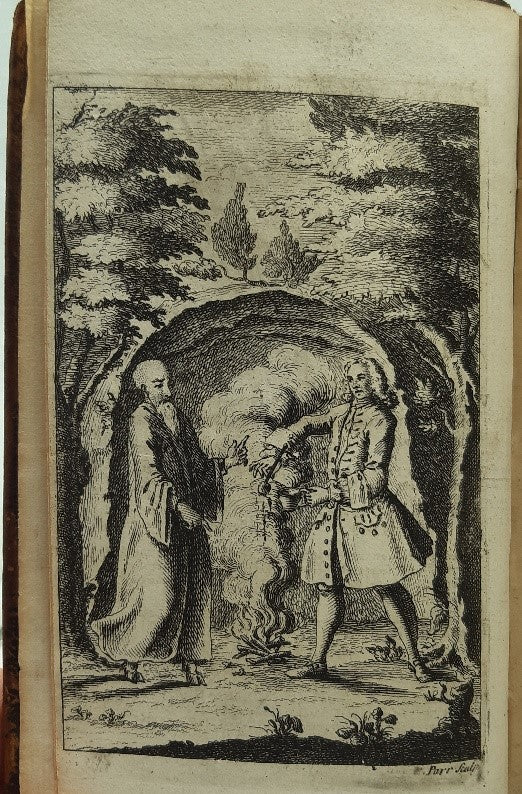The Devil turn'd Hermit: or the Adventures of Astaroth Banish'd from Hell. A Satirical Romance.
[LAMBERT DE SAUMERY, Pierre]






London: Printed and sold by J. Hodges, J. Robinson, J. Wilcox and J. Brindsley (Vol. II printed for T. Waller). 1741 and 1742.
First edition in English. In two volumes (the second without the attribution to M de M***). 12mo (Vol I, 12mo in 6s). 164x91mm. pp. xii, iv, 276; x, 254. Engraved frontispiece. Contemporary calf, double fillet in gilt to covers, rebacked with most original spines laid down., compartments decorated with double fillet in gilt, red morocco labels, lettered in gilt. Corners bumped and rubbed. Internally very good with a little marking in places and a small hole to the title page of volume two, not affecting legibility. Edges sprinkled red. Of the four variants described by ESTC, this is the first, containing the misnumbered preliminary pages, vii and xii instead of viii and xi respectively. Front pastedowns have armorial bookplate of Henry Corbet A.M. and the label of Richard Corbet, Adderley. Sir Henry was the Rector of Adderley and the last of the Corbet Baronets of Adderley and Stoke dying in 1750 without issue. Richard Corbet lived at Adderley Hall. He died in 1872. Rare in commerce and institutionally. ESTC locates five copies of the first volume in the UK and ten in the US and only two copies worldwide for the second volume. A very good copy of this vicious but amusing attack on loose French morals.
Pierre Lambert de Saumery’s scabrous satire on the French Catholic Church was first published, in two volumes, in Amsterdam in 1741 as Le diable hermite. It was clearly an immediate success being translated into English that same year, with the second English volume appearing the following year. de Saumery seems to have been an extraordinary figure. He was born in France to Calvinist parents who moved to England when Pierre was a child. He was brought up and educated in England and, at 29, became a Calvinist minister. He then travelled around the continent as a preacher ending up in Liège where he converted to Roman Catholicism. It has been suggested that his conversion was inspired less by theological conviction than by the hope of gaining access to the courts of ecclesiastical grandees. If that was so, then he was clearly successful as after a few years he published this “Satirical Romance” of life at the court of a Prince-Bishop. The conceit is that Astaroth has left hell to wander Europe where, despite having “seen in hell a great many devilish tricks” he discovers, among the French aristocracy (both secular and ecclesiastical) a venality, immorality and corruption that shock even him. “The natural order of things is all reversed in this region. They sleep in the day, riot in the night, and shorten life by unheard-of excesses. The soul is a stranger to all sincerity, and all compassion. Double-delaing, imposture, scandal, and ostentation are the only virtues known to courtiers”. Shortly after publication of Le Diable Hermite, de Saumery escaped to the Netherlands, reconverted to Calvinism and died in Utrecht in 1767.
